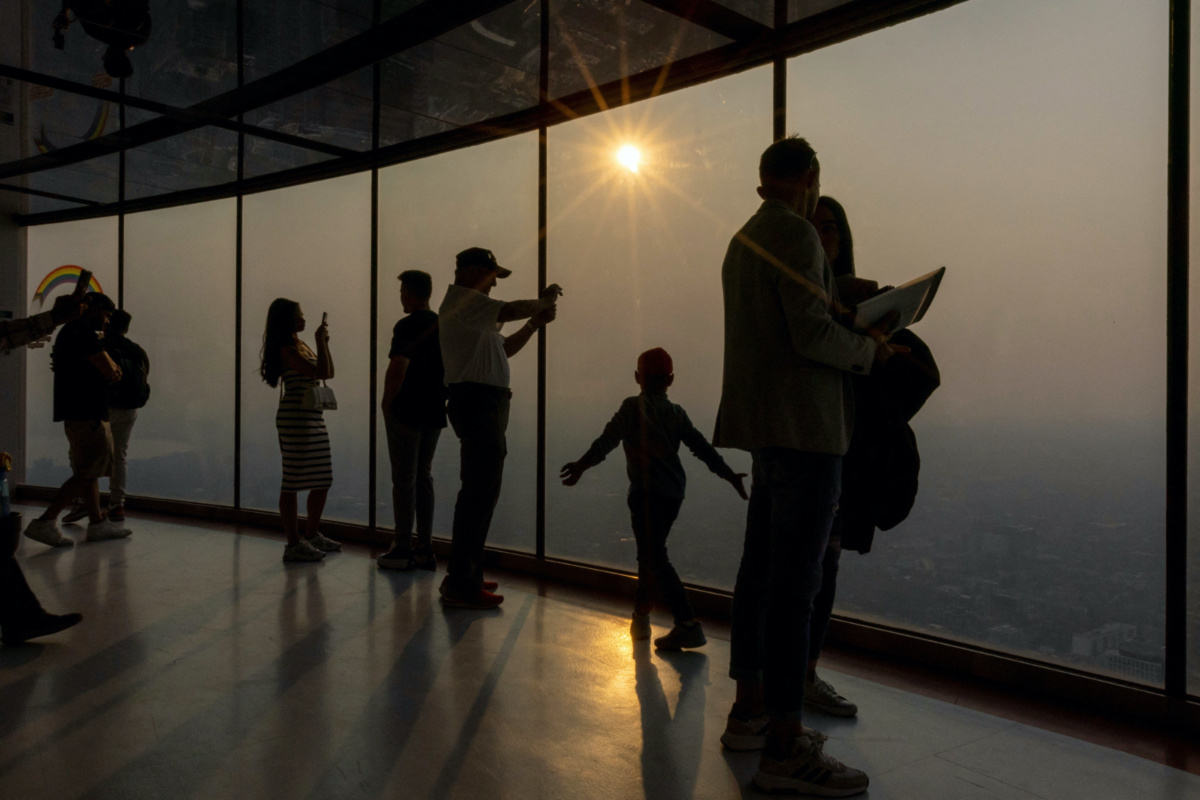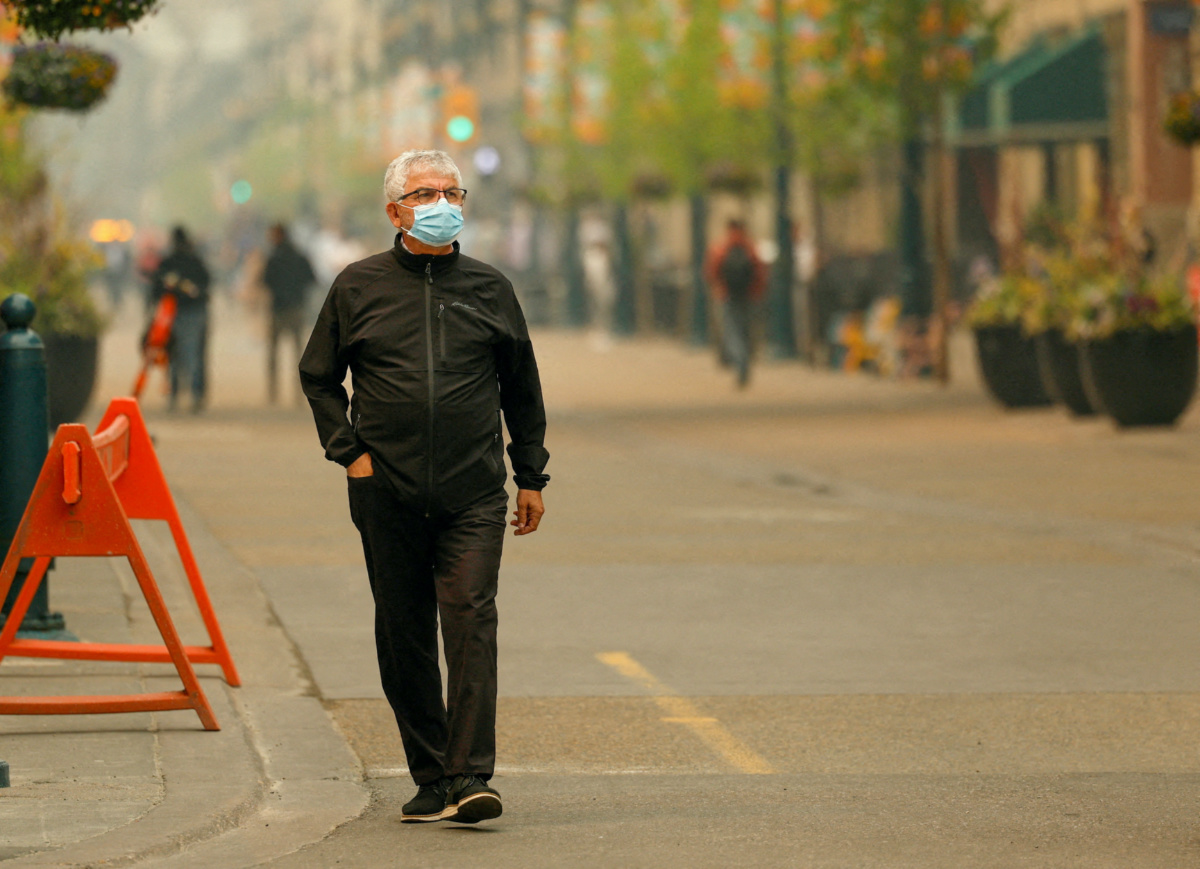Ottawa, Canada
Reuters
Allies around the world have promised to increase their help to Canada in its fight against hundreds of blazes that have swept through the country in its worst-ever start to wildfire season.
Forest fires that have gathered strength over the last month have forced tens of thousands of people from their homes and sent a smoky haze billowing over a large swath of the United States.

People take photographs as a smokey Toronto is seen from the CN Tower as wildfires in Ontario and Quebec continue to burn, in Toronto, Ontario, Canada, on 6th June, 2023. PICTURE: Reuters/Carlos Osorio/File photo.
COVID MASKS ARE BACK AS CANADIAN WILDFIRES FILL SKIES WITH SMOKE
Just when it seemed safe to unmask, some Canadians are donning the face coverings made ubiquitous during the coronavirus pandemic as a protection against hazardous smoky conditions as wildfires ravage much of the country.
Canada is seeing its worst-ever start to wildfire season as blazes burn from the western provinces to Atlantic Canada. Smoke from wildfires in Quebec has settled over southern Ontario and travelled into the United States, disrupting flights and sending people indoors.

A man wears a mask as some 90 wildfires are active in Alberta, with 23 out of control, according to the provincial government, in Calgary, Alberta, Canada, on 16th May, 2023. PICTURE: Reuters/Leah Hennel/File photo.
Some mask companies that sold protective equipment during the pandemic have turned to wildfire marketing. On Wednesday mask supplier United Canada sent out an email with “Wildfire Season Safety Tips” that included an N95 mask. Canada Strong sent out an email Tuesday titled “Ontario Smoke will be Intense – Helpful Tips.”
Neither responded Thursday when asked whether they have seen an uptick in mask interest.
Rivi Hume-Beardall could feel the difference when she stepped outside.
“It kind of hurts and just the minute I stepped outside, it was a little harder to breathe. So I just put a mask on.”
The 18-year-old Toronto resident has asthma, and “I don’t want my lungs to get damaged at all,” she told Reuters Thursday.
It’s “a little disheartening” to be wearing a mask again, she said, but “that’s what you have to do…I don’t want to regret not wearing one.”
Hume-Beardall added she hopes the spectre of smoky air “is a little bit of a wakeup call to people around the environment.”
The concern with this smoky air is particulate matter that is 2.5 microns or less in diameter – small enough to get inside not only the lungs but the bloodstream, said Samantha Green, a family doctor with Unity Health in Toronto.
Studies in people have linked wildfire smoke with higher rates of heart attacks, strokes, and cardiac arrests, increases in emergency room visits for respiratory conditions, and weakened immune defenses. Wildfires have also been linked with eye irritation and skin problems.
When the air quality health index is above 7, “then everyone who is spending time outdoors should be wearing” a mask, Green said, adding that protections are needed for people who are more exposed to air pollutants because they work outdoors or are homeless.
“We know things are worsening and we need to be better prepared on a systems level,” she added.
Marietta Haberer, 77, started wearing an N95 left over from her pandemic supply on Wednesday. The campfire smell in the air “is fine if you’re camping,” she said.
– ANNA MEHLER PAPERNY and KYAW SOE OO, Toronto, Canada/Reuters
About 4.3 million hectares have already burned, roughly 15 times the annual average of the past decade. Warm, dry conditions are expected to persist in the months ahead.
The fires have impacted mining operations in Canada and disrupted flights in the United States. On Thursday the Toronto District School Board, Canada’s largest, rescheduled or moved indoors all outside activities, including field trips and local school events.
Although wildfires are common in Canada, it is unusual for blazes to be burning simultaneously in the east and west, stretching firefighting resources, forcing the government to send in the military to help, and fueling concerns about the worsening consequences of climate change.
The US has sent hundreds of firefighters to Canada over the past few weeks and has said more help is on its way. President Joe Biden, in a statement on Thursday, said he has directed his administration to respond promptly to requests for additional firefighters and fire suppression assets.
Canadian Prime Minister Justin Trudeau, who thanked Biden for US help in a call on Wednesday, has blamed climate change for the unprecedented early season wildfires. Trudeau and Biden discussed the need to “work together to address the devastating impacts of climate change,” according to a statement from the prime minister’s office.
Democratic US Senate Majority Leader Chuck Schumer echoed the concerns about the effects of climate change on Thursday and called for the doubling of US help for Canada.
“The climate crisis is real and it is here to stay. We must take action against the climate crisis, both short-term and long-term,” Schumer said in a speech on the Senate floor.
Help has also come in from South Africa, Australia, and New Zealand. European Commission President Ursula von der Leyen said on Thursday that France, Portugal and Spain were also sending more than 280 firefighters to Canada.
Some of the worst fires have sprung up in the eastern province of Quebec, where some 12,600 people have had to evacuate their homes, provincial Public Safety Minister Francois Bonnardel told a briefing on Thursday.
“We’re not happy about the situation; though some fires are under control, some (are) not,” Bonnardel told reporters. About 132 fires are currently active in the province, down from nearly 150 on Wednesday.
Wildfire season started unseasonably early in Alberta last month and burned a record area, and Nova Scotia continues to battle its largest-ever blaze. Flames have eased in Alberta, the center of Canada’s oil and gas industry, but more than 3,000 people remain under evacuation orders and heat warnings are in effect in the south of the province.
In parts of the Pacific province of British Columbia, which is battling the second-biggest wildfire on record, temperatures were forecast to hit 33 Celsius on Thursday, before thunderstorms and heavy rains arrive on Friday.
– With DAVID LJUNGGREN






